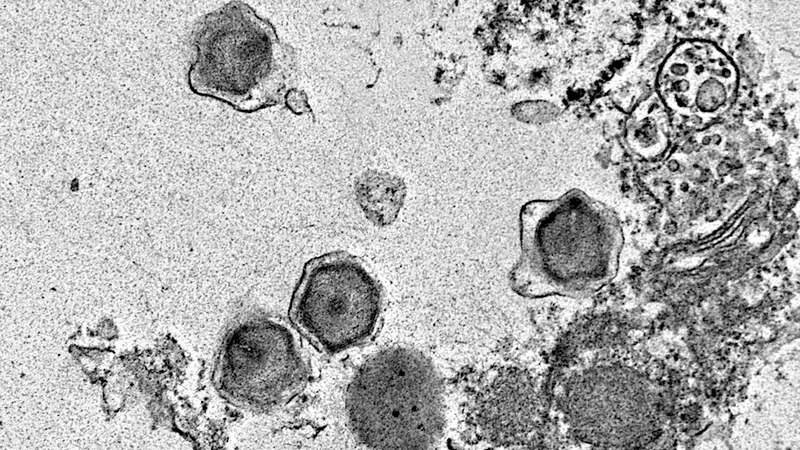
Unveiling 230 New Giant Viruses That Could Transform Our Oceans
2025-06-12
Author: Siti
Revolutionary Discovery of Giant Viruses
In an astonishing revelation, scientists have identified 230 new giant viruses that are crucial to the survival of single-celled marine organisms known as protists. These microscopic powerhouses—including algae, amoeba, and flagellates—form the foundational layer of our ocean’s food webs. But these giant DNA viruses don’t just play a passive role; they can instigate significant public health challenges, such as harmful algal blooms that threaten coastlines globally.
Game-Changing Research from the Rosenstiel School
A groundbreaking study from the Rosenstiel School of Marine, Atmospheric, and Earth Science has opened doors to understanding the diverse viral ecosystem present in our oceans. This understanding is critical for local leaders to prepare for potential algal blooms and other viral threats impacting waterways.
Utilizing cutting-edge computational methods, researchers delved into vast marine metagenomic datasets to uncover and characterize these newly discovered monsters of the microbial world.
Biotechnological Goldmine Found! New Proteins Discovered
Published in the esteemed journal Nature npj Viruses, the research unveiled new giant virus genomes that were previously unknown. Intriguingly, they identified 530 new functional proteins, including nine related to photosynthesis—hinting that these viruses might manipulate their hosts during infection, potentially altering the photosynthesis process itself.
Fighting Harmful Algal Blooms with Knowledge
Co-author Mohammad Moniruzzaman emphasized the importance of this research: "By understanding the diversity of giant viruses and their interactions with marine life, we can better predict and potentially manage harmful algal blooms—significant health hazards not just in Florida, but worldwide. The functions we discovered could open new biotechnological avenues, offering fresh enzymes that might be revolutionary for various applications."
Innovative Tools Tailored for Discoveries
Giant viruses were traditionally elusive, but the researchers developed an innovative bioinformatics tool named BEREN (Bioinformatic tool for Eukaryotic virus Recovery from Environmental metageNomes) to identify these genomes in extensive datasets.
Lead author Benjamin Minch remarked, "We found that giant viruses possess genes for cellular processes such as carbon metabolism and photosynthesis, which were thought to be exclusive to cellular life. This indicates their significant role in influencing their hosts’ metabolism and the broader marine chemical landscape."
Harnessing Supercomputing for Oceanic Insights
Utilizing the powerful Pegasus supercomputer at the Frost Institute for Data Science and Computing, the team processed enormous metagenomes, leading to a wealth of information that could reshape our monitoring of oceanic pollution and pathogens.
A Resource for Future Research
The BEREN program not only fills a research gap but also serves as an accessible resource for anyone looking to categorize giant viruses within sequencing datasets. Curious researchers can download it online, deepening our understanding of these viral giants.
A Pioneering Study with Global Implications
The study titled "Expansion of the genomic and functional diversity of global ocean giant viruses," published on April 21, 2025, stands as a testament to the ongoing exploration of our oceans. As we unlock the secrets of these viruses, we might be on the verge of a scientific revolution that reshapes our interaction with marine ecosystems.



 Brasil (PT)
Brasil (PT)
 Canada (EN)
Canada (EN)
 Chile (ES)
Chile (ES)
 Česko (CS)
Česko (CS)
 대한민국 (KO)
대한민국 (KO)
 España (ES)
España (ES)
 France (FR)
France (FR)
 Hong Kong (EN)
Hong Kong (EN)
 Italia (IT)
Italia (IT)
 日本 (JA)
日本 (JA)
 Magyarország (HU)
Magyarország (HU)
 Norge (NO)
Norge (NO)
 Polska (PL)
Polska (PL)
 Schweiz (DE)
Schweiz (DE)
 Singapore (EN)
Singapore (EN)
 Sverige (SV)
Sverige (SV)
 Suomi (FI)
Suomi (FI)
 Türkiye (TR)
Türkiye (TR)
 الإمارات العربية المتحدة (AR)
الإمارات العربية المتحدة (AR)